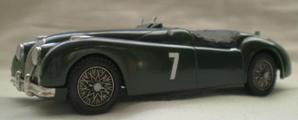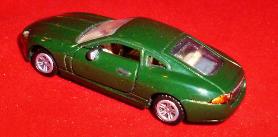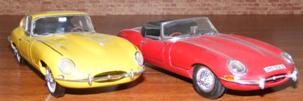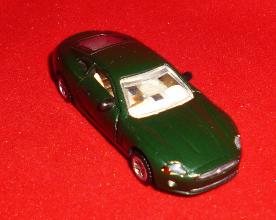The Jaguar collection
Jaguar
.....was the name given to several models produced by the SS Car Co., in the late 30’s, and was then chosen as the new company name in 1945 after WWII. The SS story began in Blackpool in 1922, when Wm. Lyons and Wm. Walmsley formed the Swallow Sidecar Co. Their success enabled them, in 1926, to fulfil an ambition of entering into car bodywork. The car they chose to endow with specialist coachwork was, interestingly enough, the very car that most threatened their livelihood as sidecar makers - the Austin 7.
In March 1935 the first true SS sports car appeared. It was the 2-seater SS90 with a 20 hp 2663cc engine. Six months later came the OHV SS 100 Jaguar. The Jaguar suffix was then adopted for all models. 0-50 in 20 seconds was hardly startling performance but the exaggerated low styling created the desired effect and public response was good.
These two models of the SS100 are; the 1935 version, in front, as produced by Matchbox in 1/32nd scale, and the South Eastern Finecast white metal kit of a 1938 car (behind and centre) in 1/24th scale.
Below them is the 1936 International Alpine rally car driven by Tommy and 'Bill' Wisdom. It was a private road going car but performed exceptionally well in the rally earning an Alpine Cup; a very prestigious award. Jaguar were so impressed they bought the car back from the Wisdoms and campaigned it themselves.
The model is a conversion from a Bburago 1/18th scale kit.

Above left is the 1/24th scale Revell kit modelled as a 1953 XK120. The racing version is a 1/32nd scale model of unknown source depicting Stirling Moss’ winning car from the 1950 Dundrodd Tourist trophy race.
The Black XK120 left is a 1/43rd scale white metal kit by Grand Prix Models kit.
Left is Johan's 'D' type kit in 1/24th scale, with a little extra work.
This kit is from Revell, in 1/24th scale and beside it is an XK engine the same as is in the car.

Airfix provided the base kit for these three 1/32nd scale E Types. The silver car built in the 1960’s features operating steering, scratch built by Rod, as seen in the picture above.
Graham Hill gave the E Type a debut victory in its first race at Oulton Park in 1961.

The Jaguar MKII was a medium sized saloon car built from 1959-67 in Coventry, it succeeded the Jaguar 2.4 and 3.4 models. These became known as the Jaguar MkI after the release of the MkII.
Tamiya gave two 1/24th versions of the car representing the road and race versions.

Two 1975 Jaguar XJ-S’ from the
1/43rd scale Airfix kit and the 1/24th scale Hasegawa kit


A major re-organisation after the war led to Jaguar Cars Ltd being set up in March 1945 and production resumed in the July. Jaguar sports car line, in abeyance since 1939 was dramatically revived in 1948 with the sensational arrival of the XK120. One of the worlds most outstanding sports cars; it found particular favour in America where, with the MG it spearheaded a sports car revival.
Demand for the car caught William Lyons by surprise, he had envisaged at most a single years manufacturing life, so the aluminium body was ‘coach built’ in the traditional manner. But such was the demand that a switch was made in 1950 to a quantity production pressed steel shell.
The roadster was joined in 1951 by an elegant fixed-head coupe version, which was followed by a drop-head model in1953. In 1955 came its successor, the XK140, so ensuring the success of a line that would endure until 1961.
After the success of the XK120, and it’s derivative the ‘C’ type, came another impressive car in the form of the D type. The series was introduced in 1954 and won consecutive victories in 1955, ‘56 and ‘57 at le Mans.
The D-Type borrowed heavily from contemporary aircraft construction. Space frame chassis construction was dropped in favour of a central stressed skin aluminium monocoque chassis (8 years before the Lotus25) with a tubular front sub-frame to which was bolted the engine, steering gear and front suspension.
With Jaguars withdrawal from racing in 1956 several D type chassis were left with no future to speak of. Sir William Lyons looked around for a way to recoup some of the investment already made and decided the American high performance sports car market might be just the place to sell a road going version of the D type race car.
A partial redesign, largely for legal and practical reasons, still left a strong family resemblance with the D type. But for a tragic fire, which destroyed not only nine cars but also the tooling and jigs for the design, production may have been far higher than the 16 it was forced to finish at. Today it is one of the most sort after cars in the world.
In 1961 they backed up that boast with the perfect combination of looks and performance. At the beginning of the 60’s Jaguar needed a quantum leap as the XK series, which had itself caused such a sensation in 1948, was fast approaching senility. Improvements such as disc brakes and a styling facelift had helped, but there was no disguising its great age.
In the experimental department chief test driver Norman Dewis was rushing around in a couple of prototype roadsters (cabriolets), as it had been intended originally to produce only an open car, but Bob Blake, a brilliant American sheet metal craftsman who worked closely with aerodynamicist Malcolm Sayer, had other ideas. He took some welding rods and mocked up a ‘fast back’ superstructure on one of the open cars. Chairman Sir William Lyons happened to walk into the experimental shop at that moment. He looked at it in silence for some time. Finally he said “Its good, we’ll make it”.
March 16th 1961 is one of the most famous dates in Jaguar Chronology. It was then that the 31st Geneva Motor Show opened its doors to the public and there could be no doubt that the star of the event was Jaguars new 150 mph E-type sports car which was unveiled - in Coupe form.
Jaguar’s large saloon line was up-dated in 1961 with the arrival of the Mk X. Excessively wide and thirsty, it was not perhaps the happiest of car designs but, like its smaller Mk II stablemate, it did get better as it got older. Announced in October 1961, seven months after the E-Type, the Mk X with its quadruple distinctive headlamps was as up to date as its Mk IX predecessor had become antiquated. The Mk X’s triple-carburettored, 3.8 litre engine was very similar to that used in the sports car. Likewise it was the beneficiary of Jaguars new independent rear suspension system that had been under development for a saloon application since 1955.
In truth, such a large car looked more in place on American than British roads and power steering, a popular Trans-Atlantic fitment, was provided as standard. Similarly the majority were equipped with automatic transmission. Like the E-Type, the Mk X received the enlarged 4.2 litre engine and all syncromesh gearbox for the manual transmission versions.
This subsequently evolved into the 420 of 1967, so called because of its 4.2 litre engine.
1967 Jaguar 420
1/32nd scale Airfix Kit.
1975 Jaguar XJ-S
A replacement for the E-Type but not its successor, the XJ-S coupe has developed into a remarkably enduring and distinctive grand tourer. It was not, initially, the most endearing of Jaguar models. Essentially styled by Malcolm Sayer, its lines in general and the distinctive rear ‘flying buttresses’ in particular, were perhaps the least satisfactory features of the design. The interior also lacked the traditional luxury of a Jaguar saloon.
The 150 mph car was launched in 1975 in the middle of the energy crisis. Then just as the XJ-S seemed to be becoming established, along came an even more damaging petrol price hike. Little wonder that the car virtually ceased production in 1980/81.
1987 Jaguar XJR-8 LM
1988 Jaguar XJR-9 IMSA and LM
1/24th scale Hasegawa kits.
1988 and Jaguar once again win the Le Mans 24 Hour Race after an interval of 31 years. It was a statement to the world that, after a traumatic decade, the company was once again a force to be reckoned with on both road and track. After some success in America a Group 44 racing programme got under way representing Jaguar, although without success, in Europe by returning to Le Mans in 1984 and again in 1985. But by this time the company had decided to back the rival UK-based, Tony Southgate XJR-6 built for Group C competition by Tom Walkinshaw Racing.
Completed in 1985, teams ran in 1986 and 1987 with the XJR-8 although in both years the Jaguars proved to be no match for the Porsche opposition. However, in 1987, the XJR-8 gave Jaguar its first ever world sports car championship victory. Then, in 1988, no less than five XJR-9s were entered for the Le Mans; one was victorious and another came in fourth. It was the first Jaguar Le Mans triumph since 1957.
A further victory followed in 1990 with XJR-12’s in first and second places, to bring to seven Jaguars triumphs in the 24 Hour classic race.
1992 XJ220 Jaguar.
1/24th scale Tamiya kit.
First presented at the 1988 motor show, at the NEC in England, it was the work of an unofficial group of Jaguars staff who got together outside of work time to come up with new ideas. Originally conceived as having a V12 engine, 4WD, antilock braking and potentially traction control and active suspension. Even four wheel steering was considered.
During tests many miles were covered on high speed runs and the car was clocked at 112mph in America June 1991. Later runs moved the top speed up to 117 mph.
1/87th scale 4D kit.
The 1996 XK8 (X100), introduced a new 32-valve, 4.0-ltr, V8 engine; the first V8 car in the range since the Daimler 250 V8 which went out of production in 1969. It was a good car but despite a series of upgrades it required more interior room and an electronics upgrade by the turn of the century prompting Jaguar to return to the drawing board for a replacement
While some described the 2006 XK as looking like an XK8 that been to the gym, the truth was this was no evolution of the previous car but significantly different car. On the outside it may have had similarly gracefully sloping lines and still exhibit the renowned Jaguar craftsmanship and quality, but now it had cutting edge technology in design, construction and onboard computational aids.
Assembled especially for you. The photo on the left is the 1/32nd scale (except the XJS which is 1/43rd.), while the one on the right is the 1/24th scale models.
It is easy to see the relative sizes of the cars and how design philosophies have changed over the years
















